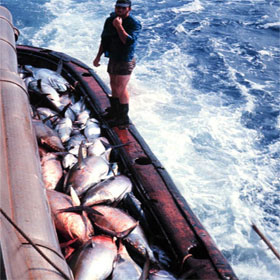|

Bigeye tuna catch. (Photo: NOAA)
Ongoing conservation measures will end the overfishing of bigeye tuna: scientists
 PALAU PALAU
Wednesday, October 12, 2011, 02:40 (GMT + 9)
Scientists believe that a continuation of the Parties to the Nauru Agreement’s (PNA) recent conservation measures and the current management action on bigeye tuna by the Western and Central Pacific Fisheries Commission (WCPFC) will halt the species’ overfishing.
The Chair of the WCPFC Scientific Committee last week spoke at the Technical and Compliance Committee of the WCPFC, presenting a summary of the updated report of Pacific tuna. It showed that the fishing mortality on bigeye tuna by purse-seiners was the lowest since 2007, and resuming current management measures would probably eradicate much of the overfishing imposed on bigeye.
“This is a significant result for the PNA”, said PNA Office Director, Dr Transform Aqorau. “It shows that the purse-seine fishery is taking its responsibilities seriously, and that the measures that we have introduced are working. It shows that PNA actions are capable of sustaining the Western and Central Pacific purse-seine fishery within precautionary levels into the indefinite future”.
The findings mainly result from three factors: a reduction in the catch of tuna in the region, the effects of the 2010 ban on the use of FADs for three months of the year and the greatly improved data resulting from the imposition of 100 per cent observer coverage by PNA countries last year.
“We would like to see the whole WCPFC membership now take up the additional measures that we introduced in 2010, including the ban on setting purse-seine nets around whale sharks, and the restriction on purse-seining in the eastern tropical high seas of the Convention area where there is a much higher percentage of bigeye in the catch. It is unfair that the majority of purse-seiners are bound by PNA licence conditions when a few, the US and the European Union (EU) vessels, can take advantage of loopholes and have so far refused to voluntarily agree to compatible restrictions,” he accused.
PNA said it will be pushing to achieve an upgraded WCPFC Conservation and Management Measure for bigeye, yellowfin and skipjack tuna at the main WCPFC annual meeting next December in Palau.
Aqorau said the PNA’s next step is to transition from ad-hoc conservation and management actions to a system that does not depend on international decisions to be made before each measure – where pre-agreed steps are activated when fisheries indicators hit precautionary reference points, as mandated by the UN Fish Stocks Agreement. PNA said it will implement such a Harvest Control Strategy within the next five years.
“The WCPFC Science Committee has been working for several years on limit reference points and has still not got the stage of making a recommendation to the Commission”, he said. “We will probably leave the Commission to come up with biologically-based limit reference points for each stock, and we will concentrate on developing target reference points and management objectives for fisheries that occur mainly in PNA waters, taking into account socioeconomic factors as well as stock and ecosystem status”.
Related articles:
- Govt invests USD 6.3 mln in Pacific fisheries
- SPC urges regional unity in fisheries management
By Natalia Real
[email protected]
www.seafood.media
Photo Courtesy of FIS Member  NOAA -National Marine Fisheries Service NOAA -National Marine Fisheries Service
|
|



